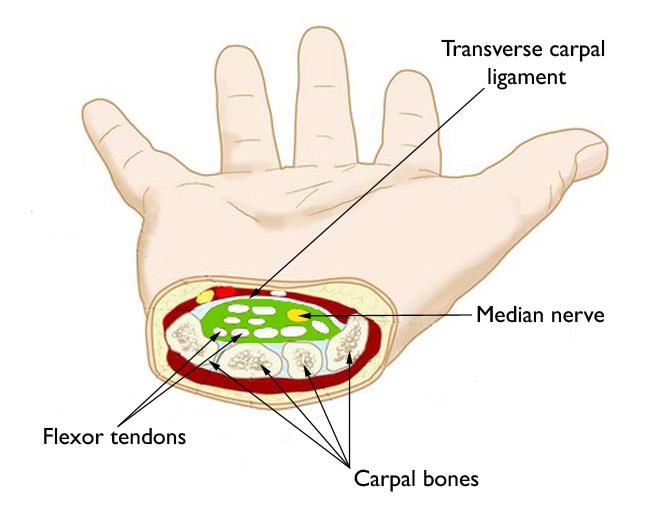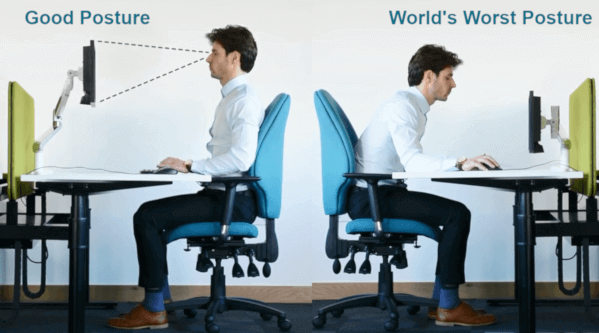Carpal Tunnel Syndrome: Symptoms and Causes
Table of Contents
Overview
Symptoms
- Numbness And Tingling
- Pain
- Weakness
What To Do
When To See A Doctor
Causes
- Primary Risk Factors
- Sex
- Wrist Anatomy
- Neuropathy-Causing Disorders
- Inflammatory Disorders
- Drugs
- Obesity
- Changes In Body Fluids
- Various Medical Disorders
- Workplace
1) Vibrating Tool Use
2) Constant Grip-And-Release
3) Prolonged Gripping
4) Rapid And Repetitive Movements
5) Prolonged Pinching
6) Maintaining A Bent (Extended) Hand
7) Working In The Cold
Carpal Tunnel Prevention
- Avoidance
- Reduce The Workplace Impact
- Maintain Good Posture
- Rest
- Stretching Exercises
- Warm Hands
Summary
FAQs
About
Overview
Carpal tunnel syndrome is one of the most common hand disorders in the USA. It is characterized by one or more of the following symptoms in the palm or fingers: pain, numbness, tingling, burning, weakness, clumsiness, shooting electric shocks, and puffy feelings. These symptoms occur when the median nerve, deep within your wrist joint, becomes irritated due to swelling and compression by adjacent tissues. Several factors can cause the compression like wrist anatomy, metabolic disturbances, overall health, and swollen flexor tendons. Treatments can vary according to your severity stage (Mild, Moderate or Severe stages of carpal tunnel syndrome). Most stages can successfully be treated with home remedies. More severe stages may require surgery. The key to any treatment is early intervention; the earlier treatment begins, the more complete the restoration of your hand function.
Symptoms
Carpal tunnel syndrome can affect anyone, and at any age. However, the
age distribution for the majority of carpal tunnel incidences in male patients is between 50 and 59 years and again between 70 and 79 years. The incidence in women usually increases with age, peaking between 50 and 59 years, and declining afterwards.
It is uncommon for the symptoms of carpal tunnel syndrome to begin rapidly. But following trauma, such as a sprained wrist, intense symptoms can occur within a week of the injury.
For most patients the disorder starts very gradually. Sometimes the progression is imperceptible. In fact, most patients attribute initial carpal tunnel symptoms to a tired or overworked hand. Most often, these initial symptoms appear only while trying to sleep. They usually include the sensations listed below.
• Numbness And Tingling
Numbness and tingling typically occur in the fingertips and palm of the hand. The thumb and pointer fingers are most frequently involved. However, the pinky finger is never affected since it is served by the ulnar nerve and not the median nerve. Tingling and numbness can wake you with the feeling of having to shake out your hand.
• Pain
The
feeling of pain can be described as aching, throbbing, shooting, itching or burning. Initially, the pain is intermittent. As symptoms begin to appear during the day, they usually occur while holding an object. Using a steering wheel, tying a shoelace or grasping a pan handle may cause symptoms to appear. When tightly grasping an object like a coffee mug or tennis racquet you may feel an
electric shock shooting from your fingers or hand and up your forearm.
• Weakness
In almost every case of carpal tunnel syndrome patients experience
hand weakness, especially as the condition advances. This is a result of having numbness (inability to feel) and weakness of the thumb muscles (another function of the median nerve). Eventually this feels like clumsiness. Patients tend to drop objects, cannot turn a doorknob or fumble with coins and keys.
What To Do
Most
studies show that the earlier you intervene in treating carpal tunnel syndrome, the more complete your remission of symptoms. Also, the earlier you treat, the faster you remission will occur.
Mild stages are easiest to treat. However, most patients ignore symptoms at the Mild stage because they attribute it to tired or overworked hands. The majority of patient begin serious intervention in the Moderate or Severe stage of carpal tunnel syndrome. While symptoms are more difficult to treat then, you still have
many good treatment options – both nonsurgical and surgical.
When To See A Doctor
The
American Academy of Orthopedic Surgeons recommends treating carpal tunnel syndrome with all conservative (nonsurgical) therapies first. If symptoms do not disappear, then surgery is usually recommended.
- Have you tried all the
recommended nonsurgical therapies?
- Do your symptoms still interfere with your sleep or your daily activities?
- Have you had moderate or severe symptoms for more than 6 months?
If you answered "yes" to all of the above, and still have symptoms, then call your doctor immediately to discuss other treatment options. The last thing you want is for symptoms to progress through the Severe stage with treatment. That’s because you risk permanent median nerve and thumb muscle damage.
Causes
The underlying reason for carpal tunnel syndrome is because of excessive pressure on your median nerve. This is a major nerve of your hand. It provides both sensation to your hand and fingers, as well as sending motor signals to various hand muscles for movement.
The median nerve travels the entire length or your arm, through your forearm and into fingers. Inside your wrist, it travels through a passageway called the “carpal tunnel” (hence the name of the disorder). This passageway is surrounded by wrist bones and other stiff structures.
Besides the median nerve, this passageway is filled with flexor tendons. These are the tendons which pull on your finger, making them curl and grasp.
The median nerve is a relatively soft structure. Surrounding it are the solid flexor tendons, all crammed into a tight, unyielding passageway. Sometimes the tissues around the nerve (especially the flexor tendons) experience irritation and start to swell. They do so within the confines of carpal tunnel. But because of the compact nature of that space, any swelling gets transmitted to the median nerve. The swelling compresses the median nerve, which is the reason we see all the symptoms of carpal tunnel syndrome.
Therefore, anything that irritates and compresses the median nerve inside the carpal tunnel space may result in carpal tunnel syndrome. For instance:
- Fluid retention from
pregnancy can cause swelling.
- So can a wrist fracture.
- Likewise, inflammation and swelling can be the result of rheumatoid arthritis.
- For many people, the swelling occurs because the flexor tendons become irritated by
repetitive stress or another mechanical strain.
In all of these instances the result is the same: compression of the median neve. But sometimes, it’s impossible to point to one single cause of carpal tunnel syndrome. Other times, the cause is a complete mystery.
Most doctors believe that the majority of carpal tunnel syndrome cases are the result of a combination of “primary risk factors”. These are variables which, alone, contribute to developing this disorder. When combined, they increase the probability of getting carpal tunnel syndrome.
Primary Risk Factors
For decades, doctors have known about several factors that are common to patients with carpal tunnel syndrome. While these "risk factors" may not be a direct “cause” of the disorder, they could increase your probability of getting it. Common to all of these risk factors is that each has the potential of increasing irritation and swelling inside the carpal tunnel passageway. That means increasing the chances of compressing the median nerve.
• Sex
Females are many times
more likely to get carpal tunnel syndrome compared to males. Some believe this is because the carpal tunnel space is relatively smaller in women. Others believe the reason is due to how flexor tendons respond to hormones. Perhaps it’s a combination of reasons.
• Wrist Anatomy
Under normal conditions, the body is in perfect alignment and balance. That’s how a normal person is born and develops. But incidences occur in life where that balance is disturbed. When the normal configuration of the wrist anatomy is disturbed, carpal tunnel can result.
Wrist sprain, fracture or dislocation can change the anatomical alignments inside the carpal tunnel space. Also, arthritis can change the shape of the wrist bones. These imbalances can result in extra pressure of the median nerve, resulting in carpal tunnel syndrome.
Finally, some people naturally have a small body frame.
Studies show that those people have a higher likelihood of getting carpal tunnel syndrome.
• Neuropathy-Causing Disorders
Some conditions and chronic illnesses are known to causing nerve damage. These include diabetes, alcoholism, hypothyroidism, and Lyme disease. These conditions can risk direct damage to the median nerve, causing
peripheral neuropathy.
• Inflammatory Disorders
Certain disorders are known to cause inflammation and swelling. These include allergic reaction, rheumatoid arthritis, autoimmune conditions, gout, and infections. When the swelling occurs in and around the wrist joint, the median nerve is at risk for being compressed.
• Drugs
Certain prescription medicines are known to be associated with carpal tunnel syndrome. They include anastrozole, exemestane, and letrozole (for treating breast cancer), disphosphonates (for treating osteoporosis), some oral anticoagulants, and some antiretrovirals.
• Obesity
Studies show that being obese puts you at risk for getting carpal tunnel syndrome. The reason is unclear.
• Changes In Body Fluids
Fluid retention may increase the pressure within the carpal tunnel. That pressure can irritate the median nerve. This is a common problem during menopause and pregnancy. If you get carpal tunnel syndrome during pregnancy there’s a
high probability that it will resolve after childbirth.
• Various Medical Disorders
Various disorders are known to be associated with carpal tunnel syndrome. They include
ATTR-CM, kidney failure, thyroid disorders, and lymphedema.
• Workplace
It’s important to note that no workplace factor has ever been directly linked with "causing" carpal tunnel syndrome. However, for decades the association between certain
occupations and the presence of carpal tunnel syndrome has been strongly established.
There are specific, harmful ways we can use our hands. These
harmful activities are common to many occupations.
1. Vibrating Tool Use
Using vibrating tools is especially harmful because it can cause carpal tunnel syndrome in addition to
Hand Arm Vibration Syndrome. Those most at risk are construction workers, masons, flooring technicians, carpenters, landscapers, polishers, and cleaners.
2. Constant Grip-And-Release
Certain occupations have this harmful activity in common. They include
hair stylists, cashiers, auto mechanics, masons, gardeners, and carpenters.
3. Prolonged Gripping
This harmful activity is common to landscapers, cyclists, tennis players, golfers, and
truckers. Long distance drivers are especially vulnerable because their hands are often raised or extended while also gripping. In addition, the steering wheel usually vibrates, which adds to the risk.
4. Rapid & Repetitive Movements
5. Prolonged Pinching
Those who write with a pen or pencil, use a stylus or tweezer, or solder small parts are at risk of hand injury and carpal tunnel syndrome. So are those sorting or making small parts on an assembly line. Carpal tunnel also disproportionately affects
fine artists, sewers,
knitters, and crafters.
6. Maintaining A Bent (Extended) Hand
If you do extensive weight training, push-ups, furniture moving, cabinet installation, farming, and truck driving, then you are at high risk for getting carpal tunnel syndrome.
7. Working In The Cold
Working with cold hands increases you chances of seeing carpal tunnel symptoms. Those at high risk are meat packers, butchers, linemen, fishermen, energy workers, mineral extractors, and forklift operators.
Carpal Tunnel Prevention
• Avoidance
The best way to
prevent carpal tunnel syndrome from happening is to avoid the harmful activity to begin with. Unfortunately, most people cannot just stop what they’re doing on the job. That means they have to use one of the other recommendations below. But if your
hobby
is causing hand or finger stress, you should curtail or eliminate it immediately.
- Can you golf or kayak less frequently?
- Can you crochet or knit for fewer hours?
- Can you discontinue push-ups, curls or pull-ups, or else find ways to un-stress your wrists?
Anything that will cut down the daily stress on your hand and wrist will help tremendously.
• Reduce The Workplace Impact
You can lessen the impact of your workplace’s harmful hand activity usually with a just a few simple modifications. For example:
- Use ergonomic tools like a keyboard or mouse.
- Switch hands to perform an activity.
- Change the angle of your wrist.
- Soften or relax your grip, even if you have to wear gloves.
- If you have to hit keys on a keyboard or cash register, hit them more softly.
• Maintain Good Posture
Many people sit at a desk, phone or computer all day long. And most people have
poor sitting posture. Hunching or slouching are the major problems. These postures exert tremendous forces on the shoulders. And those forces transmit to the hands. These harmful postures usually result from a poorly placed keyboard, mouse, screen or chair. Things to look out for are:
- While at your desk and typing, your hands must be in the neutral (straight) position as much as possible.
- Bent wrists are very bad; be sure the keyboard is roughly at the height of your elbows or slightly lower.
- Adjust your screen so your head does not have to move up or down too much.
- Sit with your back straight and feet firmly on the floor.
- Use an ergonomic mouse.
• Rest
Rest doesn’t mean going to sleep. It means to rest your hands periodically in order to minimize the impact of the stressful activity. A good general rule is to rest for 1-2 minutes for every half hour of stressful finger/hand activity. Best practice is to perform stretching exercises (see next) during that rest period.
• Stretching Exercises
Stretching exercises have long been known to help lessen the probability of getting carpal tunnel syndrome. That’s because stretching lubricates tendons and breaks up adhesions which can cause inflammation. There are
4 core stretching exercises which are quick and easy to do, especially during your rest breaks (see above). Best practice is to do the stretches every 30-60 minutes of stressful hand activity.
• Warm Hands
Keeping your hands warm is essential to good hand health. And even though you may not get carpal tunnel syndrome in a cold environment, you invite finger stiffness and pain. Try wearing
thermal gloves. If needed, fingerless gloves can offer dexterity while warming your hand and wrist.
Summary
Carpal tunnel syndrome is a common hand disorder afflicting millions. Symptoms usually include hand and finger numbness, pain, tingling, burning, and weakness. At its core, carpal tunnel syndrome is a dysfunction of your median nerve. Specifically, the nerve becomes crushed by surrounding tissues because they swell and expand, for one of several reasons. That crushing is the underlying reason for all the symptoms of carpal tunnel syndrome. Sometimes the swelling is due to medical conditions like pregnancy or diabetes. Other times it is due to swollen flexor tendons. Tendon swelling can occur if you engage in harmful hand activities such as constant gripping or rapid and repetitive finger/hand movement. You can prevent carpal tunnel syndrome if you take one or more precautions such as avoiding the harmful activity, wearing gloves, doing stretches, and adjusting your sitting posture.
FAQs
• Can symptoms of carpal tunnel disappear without treatment?
Sometimes symptoms can resolve on their own, particularly in the Mild stage of the disorder. But in Moderate or Severe stages, spontaneous resolution is rarer.
• How can you tell if it’s carpal tunnel versus something else?
You can perform
specific tests at home to determine if you have carpal tunnel syndrome. Or else you can visit you doctor for a complete diagnosis.
• What if I can’t quit my job, yet have to perform the same harmful hand activities?
This is always a tough call. You will have to decide on what’s more important; your occupation or your comfort. If you cannot eliminate the symptoms with any remedy (including surgery) then performing the same tasks will only worsen your condition.
About











